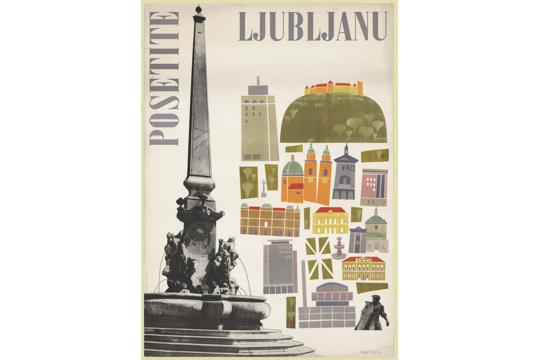
19/06/2015
The exhibition A Century of the Poster will be held in MAO, Ljubljana from 16 June to 1 November 2015
The exhibition A Century of the Poster is a retrospective of the poster's development as a mass medium of visual communication and a central assignment for the Slovenian graphic design in the 20th century. The exhibition presents more than 200 posters designed by more than 80 authors. The majority of exhibits comes from the MAO collection, while some are the property of Slovenian public libraries, museums, state archives and private collections.
In Slovenia, the first attempts at modern poster design, one that combined image and text to create a new form of visual communication, can be traced back to the beginning of the 20th century when painters and architects, among them Janez Jager, Rihard Jakopič, Gvidon Birolla, Ivan Vavpotič, Maksim Gaspari and Saša Šantel, joined in the creative process. Poster design became more diverse in the period between the two wars; there was a proliferation of advertising posters, in particular, as well as of tourism posters. Posters gained considerable ground in culture also, with Janko Omahen, Domicijan Serajnik, Peter Kocjančič, Janez Trpin and Gojmir Anton Kos as their authors.
It was in the 1950s that Slovenian poster art underwent radical changes in the form of a more modern design language, as practiced by the first post-war generation of architects (Uroš Vagaja, Grega Košak, Majda Dobravec, Jože Brumen and others). Under the influence of architect Edvard Ravnikar, this generation began to explore contemporary approaches to a more elaborate and effective poster narrative. This was the first generation of graphic designers to establish modernism in Slovenian graphic design.
The early 1970s saw a new generation of graphic designers enter the design arena. They were either graduates of the Ljubljana school of architecture or had attended foreign schools of design in either the West (Venice, Milan) or the East (Warsaw). Peter Skalar, Janez Suhadolc, Judita Skalar, Oskar Kogoj, Tomaž Kržišnik and Matjaž Vipotnik are among the more prominent designers of this period. They were followed by Jani Bavčer, Nino Kovačević, Miljenko Licul, Ranko Novak and others. Under the influence of the parallel postmodernist paradigm, they developed new ways of expression that introduced an element of ambiguity and left more room for interpretation.
The modern poster narrative enjoyed a smooth and measured development process throughout the time of socialism as Slovenian designers were able to follow contemporary trends in graphic design or even established them, as demonstrated in particular by the posters of Matjaž Vipotnik and New Collectivism in the 1980s.
In the second half of the 20th century, poster was recognized as an important medium for the affirmation of the new political order. On the other hand, starting in the 1950s, other types of poster enjoyed relatively undisturbed development as well: advertising poster, tourism poster, sports poster, ecological poster and particularly cultural poster (film, exhibition, music, theater). The resemantization of party symbols began in the 1970s and was first reflected in the political posters (congress posters) of the time. With the coming of the 1980s and the economic and political crises that came with it, these shifts found a radical echo in the cultural posters of the time, with political messages sometimes disguised in symbolism (theater and exhibition posters), and in other types of posters (music poster) that appropriated and fully identified with the discourse of the authorities. With their poster for the 1987 Youth Day Celebration, where they applied their retroprinciple, a combination of recycling and montage, whereby the artists relied on the element of surprise, New Collectivism emerged as the most radical practitioners.
In the context of graphic design, the role of the poster throughout the 20th century – which in view of the massive production of posters for every aspect of social life could be described as the century of the poster – is widely recognized as particularly important, at certain moments even groundbreaking. Above all, however, the poster of the last century established itself as an autonomous medium whose power of communication, irrespective of its type or public visibility, had a very considerable impact on society and on the changes that shaped and defined the century.
The exhibition will be accompanied by a book titled "A century of the poster: The 20th Century Poster in Slovenia", dedicated to the development of the poster throughout the final century of the last millenium. Authored by Cvetka Požar, the book takes the reader on an interesting journey through the historic development of this important propaganda medium, its role in our region and its inherent rules that changed with the time and adapted to the demands of individual periods. The work represents a comprehensive overwiev of the Slovenian poster through time.
The exhibition is curated by Cvetka Požar
For more info go to mao.si